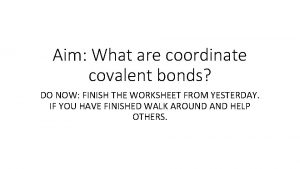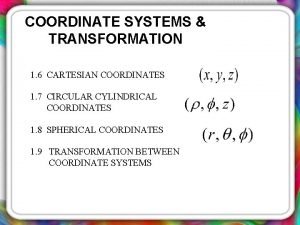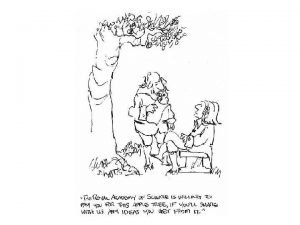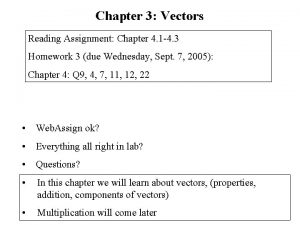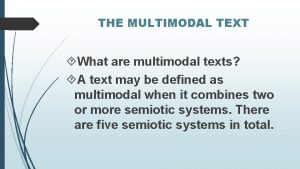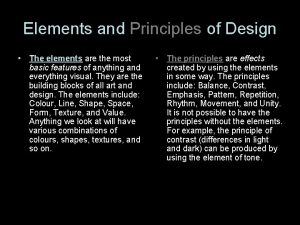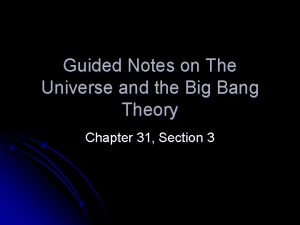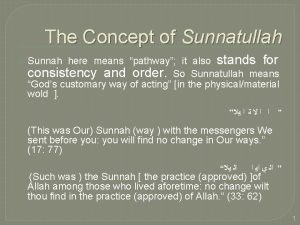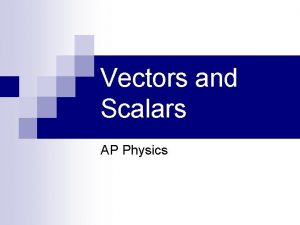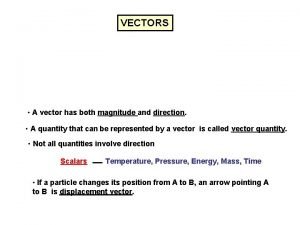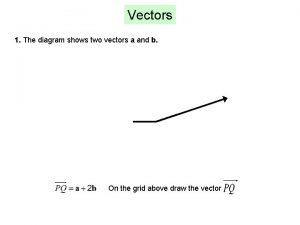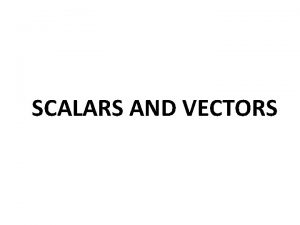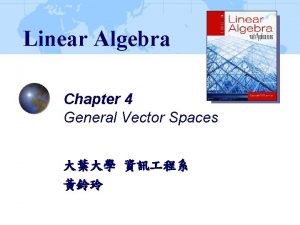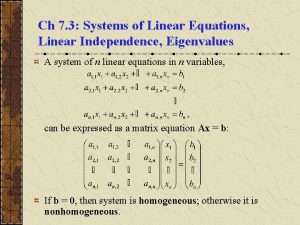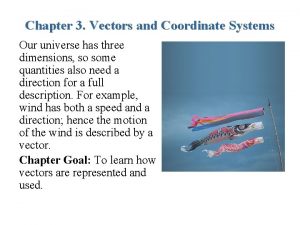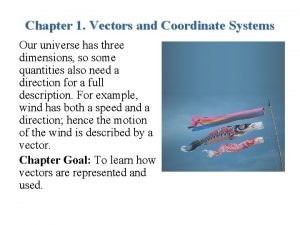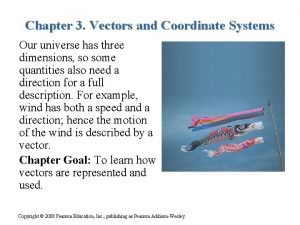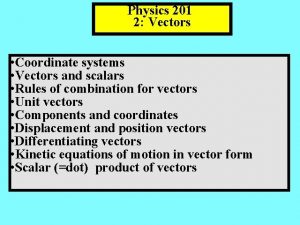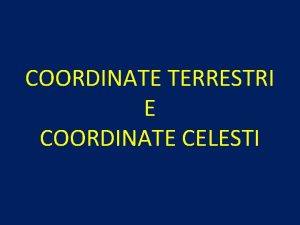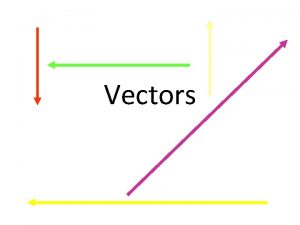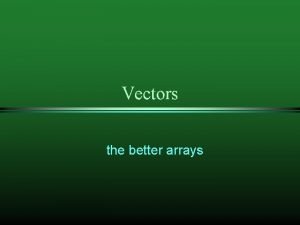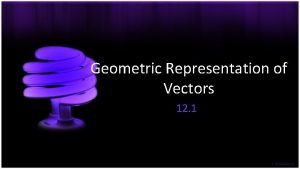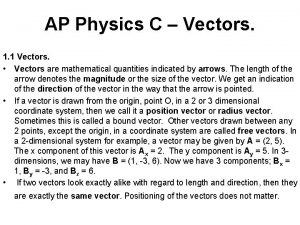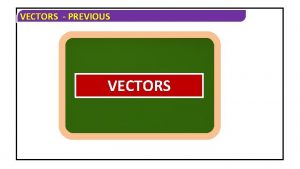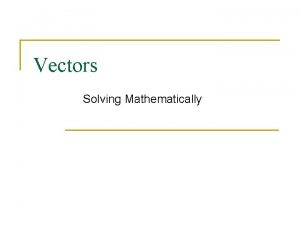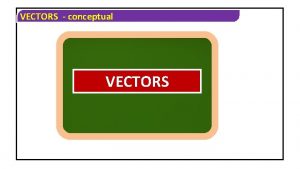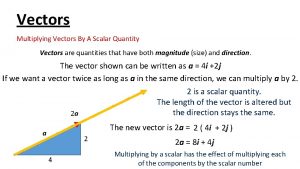Chapter 3 Vectors and Coordinate Systems Our universe















































- Slides: 47

Chapter 3. Vectors and Coordinate Systems Our universe has three dimensions, so some quantities also need a direction for a full description. For example, wind has both a speed and a direction; hence the motion of the wind is described by a vector. Chapter Goal: To learn how vectors are represented and used. Copyright © 2008 Pearson Education, Inc. , publishing as Pearson Addison-Wesley.

Student Learning Objectives – Ch. 3 • To understand the basic properties of vectors. • To add and subtract vectors both graphically and using components. • To be able to decompose a vector into its components and to reassemble vector components into a magnitude and a direction. • To recognize and use the basic unit vectors. • To work with tilted coordinate systems. Copyright © 2008 Pearson Education, Inc. , publishing as Pearson Addison-Wesley.

Copyright © 2008 Pearson Education, Inc. , publishing as Pearson Addison-Wesley.

Copyright © 2008 Pearson Education, Inc. , publishing as Pearson Addison-Wesley.

Graphical Vector Addition Copyright © 2008 Pearson Education, Inc. , publishing as Pearson Addison-Wesley.

Tip to Tail Method Copyright © 2008 Pearson Education, Inc. , publishing as Pearson Addison-Wesley.

Parallelogram Method Copyright © 2008 Pearson Education, Inc. , publishing as Pearson Addison-Wesley.

Vector Addition Problem • Which figure shows A 1 + A 2 + A 3? Copyright © 2008 Pearson Education, Inc. , publishing as Pearson Addison-Wesley.

Which figure shows Copyright © 2008 Pearson Education, Inc. , publishing as Pearson Addison-Wesley. ?

Multiplication by a scalar Copyright © 2008 Pearson Education, Inc. , publishing as Pearson Addison-Wesley.

Vector Subtraction Copyright © 2008 Pearson Education, Inc. , publishing as Pearson Addison-Wesley.

Vector Subtraction • Which figure shows 2 A – B? Copyright © 2008 Pearson Education, Inc. , publishing as Pearson Addison-Wesley.

Which figure shows 2 − Copyright © 2008 Pearson Education, Inc. , publishing as Pearson Addison-Wesley. ?

Components of vectors Copyright © 2008 Pearson Education, Inc. , publishing as Pearson Addison-Wesley.

Magnitude of A: A = (Ax 2 + Ay 2)1/2 Direction of A: θ = tan-1 (Ay/Ax) Copyright © 2008 Pearson Education, Inc. , publishing as Pearson Addison-Wesley.

What are the x- and y-components Cx and Cy of vector ? A. B. C. D. E. Cx = 1 cm, Cy = – 1 cm Cx = – 3 cm, Cy = 1 cm Cx = – 2 cm, Cy = 1 cm Cx = – 4 cm, Cy = 2 cm Cx = – 3 cm, Cy = – 1 cm Copyright © 2008 Pearson Education, Inc. , publishing as Pearson Addison-Wesley.

What are the x- and y-components Cx and Cy of vector ? A. B. C. D. E. Cx = 1 cm, Cy = – 1 cm Cx = – 3 cm, Cy = 1 cm Cx = – 2 cm, Cy = 1 cm Cx = – 4 cm, Cy = 2 cm Cx = – 3 cm, Cy = – 1 cm Copyright © 2008 Pearson Education, Inc. , publishing as Pearson Addison-Wesley.

Copyright © 2008 Pearson Education, Inc. , publishing as Pearson Addison-Wesley.

Copyright © 2008 Pearson Education, Inc. , publishing as Pearson Addison-Wesley.

Workbook problems 12, 13, 15, 16, 18 Copyright © 2008 Pearson Education, Inc. , publishing as Pearson Addison-Wesley.

Workbook problems 12, 13, 15, 16, 18 answers Copyright © 2008 Pearson Education, Inc. , publishing as Pearson Addison-Wesley.

Copyright © 2008 Pearson Education, Inc. , publishing as Pearson Addison-Wesley.

Copyright © 2008 Pearson Education, Inc. , publishing as Pearson Addison-Wesley.

Workbook exercises 25 -29 Copyright © 2008 Pearson Education, Inc. , publishing as Pearson Addison-Wesley.

Workbook exercises 25 -29 - answers Copyright © 2008 Pearson Education, Inc. , publishing as Pearson Addison-Wesley.

Tilted axes • Often is it convenient to tilt the coordinate axes (to represent an object on an incline for example). • The axes stay perpendicular to each other. • The unit vectors corespond to axes, not to “horizontal and vertical” so they are also tilted. Copyright © 2008 Pearson Education, Inc. , publishing as Pearson Addison-Wesley.

Tilted axes • Cx = C cos θ • Cy = C sin θ • Note that θ is defined relative to the tilted x-axis and not to “horizontal” Copyright © 2008 Pearson Education, Inc. , publishing as Pearson Addison-Wesley.

Copyright © 2008 Pearson Education, Inc. , publishing as Pearson Addison-Wesley.

EXAMPLE 3. 7 Finding the force perpendicular to a surface Copyright © 2008 Pearson Education, Inc. , publishing as Pearson Addison-Wesley.

EXAMPLE 3. 7 Finding the force perpendicular to a surface Copyright © 2008 Pearson Education, Inc. , publishing as Pearson Addison-Wesley.

EXAMPLE 3. 7 Finding the force perpendicular to a surface Copyright © 2008 Pearson Education, Inc. , publishing as Pearson Addison-Wesley.

Workbook problems 26, 27, 28, 30, 31 Copyright © 2008 Pearson Education, Inc. , publishing as Pearson Addison-Wesley.

Copyright © 2008 Pearson Education, Inc. , publishing as Pearson Addison-Wesley.

Copyright © 2008 Pearson Education, Inc. , publishing as Pearson Addison-Wesley.

Copyright © 2008 Pearson Education, Inc. , publishing as Pearson Addison-Wesley.

Chapter 3. Summary Slides Copyright © 2008 Pearson Education, Inc. , publishing as Pearson Addison-Wesley.

Important Concepts Copyright © 2008 Pearson Education, Inc. , publishing as Pearson Addison-Wesley.

Important Concepts Copyright © 2008 Pearson Education, Inc. , publishing as Pearson Addison-Wesley.

Using Vectors Copyright © 2008 Pearson Education, Inc. , publishing as Pearson Addison-Wesley.

Using Vectors Copyright © 2008 Pearson Education, Inc. , publishing as Pearson Addison-Wesley.

Using Vectors Copyright © 2008 Pearson Education, Inc. , publishing as Pearson Addison-Wesley.

Using Vectors Copyright © 2008 Pearson Education, Inc. , publishing as Pearson Addison-Wesley.

Chapter 3. Clicker Questions Copyright © 2008 Pearson Education, Inc. , publishing as Pearson Addison-Wesley.

Which figure shows Copyright © 2008 Pearson Education, Inc. , publishing as Pearson Addison-Wesley. ?

Which figure shows 2 − Copyright © 2008 Pearson Education, Inc. , publishing as Pearson Addison-Wesley. ?

Angle φ that specifies the direction of is given by A. tan– 1(Cy /Cx) B. tan– 1(Cx /|Cy|) C. tan– 1(Cy /|Cx|) D. tan– 1(Cx /Cy) E. tan– 1(|Cx |/|Cy|) Copyright © 2008 Pearson Education, Inc. , publishing as Pearson Addison-Wesley.

Angle φ that specifies the direction of is given by A. tan– 1(Cy /Cx) B. tan– 1(Cx /|Cy|) C. tan– 1(Cy /|Cx|) D. tan– 1(Cx /Cy) E. tan– 1(|Cx |/|Cy|) Copyright © 2008 Pearson Education, Inc. , publishing as Pearson Addison-Wesley.
 Post coordinate indexing example
Post coordinate indexing example Covalent bond co
Covalent bond co Awareness of ourselves and our environment is
Awareness of ourselves and our environment is Our awareness of ourselves and our environment
Our awareness of ourselves and our environment Awareness of ourselves and our environment is
Awareness of ourselves and our environment is Our awareness of ourselves and our environment
Our awareness of ourselves and our environment Chapter 30 galaxies and the universe
Chapter 30 galaxies and the universe A 100 lb weight hangs from two wires
A 100 lb weight hangs from two wires Dot product
Dot product Transformation between two cartesian coordinate systems
Transformation between two cartesian coordinate systems Rotating coordinate systems
Rotating coordinate systems Thinking language and intelligence
Thinking language and intelligence Our census our future
Our census our future Christ be our light
Christ be our light Marcus aurelius our life is what our thoughts make it
Marcus aurelius our life is what our thoughts make it We bow our hearts
We bow our hearts Our census our future
Our census our future Our life is what our thoughts make it
Our life is what our thoughts make it Money madness short summary
Money madness short summary God our father christ our brother
God our father christ our brother Our future is in our hands quotes
Our future is in our hands quotes Chapter 26 exploring the universe answers
Chapter 26 exploring the universe answers Statics vectors
Statics vectors Chapter 3 vectors worksheets
Chapter 3 vectors worksheets This chapter shows how vectors can be added using
This chapter shows how vectors can be added using What is multimodal text
What is multimodal text Economics unit 1 lesson 2 difficult choices
Economics unit 1 lesson 2 difficult choices Decision support systems and intelligent systems
Decision support systems and intelligent systems What is the answer to life the universe and everything
What is the answer to life the universe and everything Life and death of a star
Life and death of a star The scale of the universe is measured in
The scale of the universe is measured in Design elements and principles of the universe
Design elements and principles of the universe Guided notes on the universe and big bang theory
Guided notes on the universe and big bang theory Structure and evolution of the universe. lesson 1
Structure and evolution of the universe. lesson 1 Sunatullah saadat ne dedi
Sunatullah saadat ne dedi Directed line segment math definition
Directed line segment math definition A storm system moves 5000 km due east
A storm system moves 5000 km due east Tan-1(ry/rx)
Tan-1(ry/rx) Vector scalar multiplication
Vector scalar multiplication Vector has both magnitude and direction
Vector has both magnitude and direction Trapezium vector
Trapezium vector Kinematics 2d formulas
Kinematics 2d formulas What is vector quantity
What is vector quantity Scalars and vectors
Scalars and vectors Chapter 4 vector spaces
Chapter 4 vector spaces Linearly dependent and independent vectors
Linearly dependent and independent vectors Vectors and the geometry of space
Vectors and the geometry of space Linearly dependent vectors
Linearly dependent vectors

